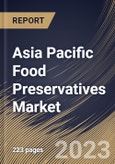Preserving the freshness of fruits and vegetables without compromising their nutritional content is a delicate balance. Innovations in preservation technologies, such as controlled atmosphere storage and modified atmosphere packaging (MAP), offer alternatives to traditional preservatives. These approaches create environments that slow the aging process, extending the shelf life of fresh produce and minimizing nutrient degradation.
Additionally, fruit juices are particularly challenging to preserve due to their natural sugars and enzymes, which can contribute to flavor changes and color degradation over time. Preservatives are employed to inhibit enzymatic browning and microbial activity, preserving the fresh and natural flavors of the juice. Fermentation is a common concern in fruit juices, especially when natural sugars are present. Unintended fermentation alters the taste and can lead to the generation of alcohol, which may be undesirable in non-alcoholic beverages. Preservatives need to counteract the potential for fermentation while maintaining the authenticity of the fruit's flavor.
The Asia Pacific region is becoming a significant player in the global dairy trade. There is an increasing adoption of Western dietary habits, including a greater consumption of dairy products such as milk, yogurt, and cheese. As per the data released by the State Council of China in May 2022, in May, the annual output of the leading dairy corporations in China increased by 2.9 percent. In May 2022, these businesses, each generating a minimum of 20 million yuan ($2.99 million) in annual operating revenue, manufactured approximately 2.76 million metric tons of dairy products. Therefore, the rising dairy production in Asia Pacific is expected to help grow the regional market.
The China market dominated the Asia Pacific Food Preservatives Market by Country in 2022 and would continue to be a dominant market till 2030; thereby, achieving a market value of $320 million by 2030. The Japan market is registering a CAGR of 5.1% during (2023 - 2030). Additionally, The India market would showcase a CAGR of 6.5% during (2023 - 2030).
Based on Function, the market is segmented into Anti-microbial, Anti-oxidant, and Others. Based on Type, the market is segmented into Natural (Edible Oil, Rosemary Extracts, Natamycin, Vinegar, Others), and Synthetic (Sorbates, Benzoates, Propionates, Others). Based on Application, the market is segmented into Meat & Poultry Product, Bakery Products, Dairy Product, Beverages, Snacks, and Others. Based on countries, the market is segmented into China, Japan, India, South Korea, Singapore, Malaysia, and Rest of Asia Pacific.
The market research report covers the analysis of key stake holders of the market. Key companies profiled in the report include Archer Daniels Midland Company, Cargill, Incorporated, Kerry Group, Plc., Akzo Nobel N.V., Kemin Industries, Inc., Univar Solutions, Inc., Koninklijke DSM N.V., Tate & Lyle Plc., BASF SE, Celanese Corporation.
Scope of the Study
Market Segments Covered in the Report:
By Function (Volume, Kilo Tonnes, USD Billion, 2019-2030)- Anti-microbial
- Anti-oxidant
- Others
- Natural
- Edible Oil
- Rosemary Extracts
- Natamycin
- Vinegar
- Others
- Synthetic
- Sorbates
- Benzoates
- Propionates
- Others
- Meat & Poultry Product
- Bakery Products
- Dairy Product
- Beverages
- Snacks
- Others
- China
- Japan
- India
- South Korea
- Singapore
- Malaysia
- Rest of Asia Pacific
Key Market Players
List of Companies Profiled in the Report:
- Archer Daniels Midland Company
- Cargill, Incorporated
- Kerry Group, Plc.
- Akzo Nobel N.V.
- Kemin Industries, Inc.
- Univar Solutions, Inc.
- Koninklijke DSM N.V.
- Tate & Lyle Plc.
- BASF SE
- Celanese Corporation
Unique Offerings
- Exhaustive coverage
- The highest number of Market tables and figures
- Subscription-based model available
- Guaranteed best price
- Assured post sales research support with 10% customization free
Table of Contents
Companies Mentioned
- Archer Daniels Midland Company
- Cargill, Incorporated
- Kerry Group, Plc.
- Akzo Nobel N.V.
- Kemin Industries, Inc.
- Univar Solutions, Inc.
- Koninklijke DSM N.V.
- Tate & Lyle Plc.
- BASF SE
- Celanese Corporation








